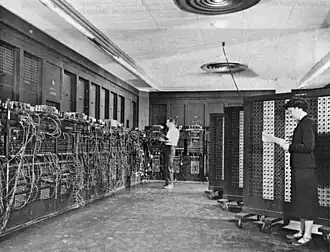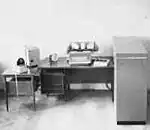History of computer hardware in Yugoslavia
| History of computing |
|---|
 |
| Hardware |
| Software |
| Computer science |
| Modern concepts |
| By country |
| Timeline of computing |
|
| Glossary of computer science |
|
To protect domestic production from foreign competition, which was often done to an excessive degree and to the detriment of the local consumer and industry, the Socialist Federal Republic of Yugoslavia (SFRY) enforced strict import regulations. These restrictions had a role in the development of the computer industry in this country, other than in the Western world. One of the fundamental ideologies that influenced computer development in Yugoslavia was the need for independence from foreign manufacturers producing spare parts, contributing to the development of domestically produced computers.
Development
Early computers
In former Yugoslavia, at the end of 1962 there were 30 installed electronic computers, in 1966, there were 56, and in 1968 there were 95.[1]After receiving specialised training (in foreign computer institutes: in Paris in 1954 and 1955 (T. Aleksić and A. Mandžić); in Darmstadt and Vienna in 1959 (V. Masnikosa); in Cambridge in 1961 (P. Vrbanac) and in London in 1964 (D. Hristović), engineers from the BK-Vincha Institute, later accompanied with engineers form the Michailo Pupin Institute in Belgrade, led by professor doctor Tihomir Aleksić, began development of first domestic computer hardwares in late 1950s. This project resulted in creation of CER series of computers (Cifarski Elektronski Računar - ,,Digital Electronic Computer"), beginning with the model CER-10, developed in Vincha in year 1960, a computer based on vacuum tube and electronic relays.
By the year 1964, development of computer CER-20 was finished, which was intended to serve as an "electronic bookkeeping machine”, given the manufacturers recognition of the ever-growing accounting market. The special-purpose trend of business-computer development was continued with creation of the CER-22 model in 1967, intended for use in banks and communal businesses for online operations.
There were also other CER models, such as CER-12, CER-11, CER-111 and CER-200, but there is not enough information available.
During late 1970s, ,,Ei-Niš computer center” from Niš, Serbia, began constructing Mainframe H6000 computer models under Honeywell licence, which were intended to be used mainly for banking purposes. In the beginning, the computer was a great success, which led to expansion of local industry in areas lacking availability. The company was also constructing models such as H6 and H66, which remained popular even in early 2000s, under the name ,,Bull HN”. The H6 models were assembled in enterprises like telecom and ran the GCOS operating system. They were also used for education purposes - Honeywell's H6 model was installed in school of electronic engineering and trade ,,Nikola Tesla” in Niš, and was used for education and training during the 80s, until creation of personal computers.
Import
Over time, as it began to be more apparent that domestic science and industry are not yet in capacity to keep track with global computer development, foreign computers were allowed to be imported in the country, under specific conditions and permits. Consequently, this led to the market being overdominated by foreign products, reducing the relative market share of locally produced computers. On the contrary, and caused by the increasing demand on the market, systems made by local companies, such as Michailo Pupin Institute (initially CER series and later TIM series, e.g., TIM-100 and TIM-600) and Iskra Delta (e.g., model 800, based on PDP-11/34) continued with their development during the 1970s, even into the 1980s.[2]
Early 1980s: Home computer era
Many different companies that attempted to create microcomputers similar to home computers from 1980s, such as Ivo Lola Ribar Institute's Lola 8, Michailo Pupin Institute's TIM-001, EI's Pecom 32 and 64,[3] PEL Varazdin's Galeb (computer) and Orao, Ivel Ultra and Ivel Z3, etc. Josef Stefan Institute in Ljubljana made first 16-bit microcomputer PMP-11 under the leadership of Maryan Miletich, former technical director of Iskra-Delta in 1984. It had 8 MHz DEC T-11 CPU, maximum of 64 kB RAM, 10 MB hard disk, 8" diskette and two RS-232 ports for VT-100 video terminal and COM. Branko Jevtich modified RT-11 operating system so plenty of DEC-11 applications were available. Some 50 machines were made before IBM AT became widely available. Multiple factors prevented them from reaching success on markets outside the house computer market:
- they were overly expensive for individual consumers (specially in comparison to popular foreign computers such as ZX Spectrum, Commodore 64, etc.),
- limited selection of entertainment and other types of programs made them appear unattractive to the contemporary computer enthusiasts,
- they were unavailable for purchase in stores.
As a result, domestically manufactured computers of these generations were predominantly used in government institutions which were prohibited purchase of imported equipment. The computers which could have been connected to the existing mainframe computers as terminals reached greater success in business companies, while others were used in schools for education purposes. Given that all medium and large enterprises in the country were government-owned, this was still a significant part of the domestic market which explains both the unnatural, relative success of domestic business computers, as well as why IBM PC/AT and compatibles had a low influx in the local business market.
Government, in attempt to prevent import of foreign computers from growing, introduced restrictions in terms of price and memory size. In spite of those restrictions, consumers continued importing foreign computers, either illegaly or disassembled in parts, which made it possible for them to bypass restrictions. This case of improper legislation, and an example of what is called the ,,grey market” is what further contributed to the collapse of domestic home computer industry. By the middle of the decade home computer market was, much like in the rest of the Europe, dominated by Commodore 64 and ZX Spectrum as a runner up.
One computer model managed to stand out - Galaksija (eng. Galaxy), whose creator, Voja Antonich, in a special issue of a popular magazine called Galaksija, under the name Računari u vašoj kući (eng. Computers in your home), published the diagrams and instructions for unassisted construction of the video game computer, in January 1984. Although initially not available for purchase in assembled form, the computer was built unassisted by thousands of enthusiasts, and a small amount of them was produced for usage in elementary and high schools.
Home computers had become so popular in the SFRY that even certain radio stations broadcast programs usually distributed by compact cassettes (e.g. Ventilator 202 series, Radio Študent Ljubljana, etc.). Software piracy (copyright infringement of software) was a common phenomenon and pirates freely issued their advertisements even in popular computer magazines such as Računar (eng. Computer), Svet kompjutera (eng. Computer world), Moj mikro (eng. My micro) and Revija za mikroračunala (eng. Journal of microcomputers). The cheap pirate software made it possible for any home computer owner to become self-developed collectionary of hundreds of programs, which had both positive and negative economic consequences; resources for development were easily accessible which produced a great number of various specialists who were known worldwide, but failed to succeed on their local market due to the same piracy which made their education available.
Late 1980s - era of personal computers (PC)
The second half of the 1980s brought increased popularity of IBM PC compatible computers among business users, and a fewer number 16-bits computers like Amiga and Atari ST, but mostly on the enthusiast market. The mainstream home computer market was still largely dominated by the ubiquitous C-64. Local manufacturers also created some IBM PC compatible computer models, such as those from TIM series of microcomputers (IMP) (e.g. TIM-100 and Lira), and the first domestic Unix workstation; Iskra Delta’s Triglav was in one of the configurations shipped with the Microsoft Xenix. However, their success was limited only to the institutions obliged to use domestically produced equipment.
Grey economy (illegal economic activity) continued to pressist and facilitate market dominance of foreign produced technology amongst local consumers, and software infringement remained alive until the very end of SFRY in the 1990s. Just before the collapse of the Federal Republic in 1989., a company called Sesam started a local distribution of personal computers around the Belgrade area, which included the popular ,,Konferencija" (eng. Conference). In 1996., Sesam reoriented to Internet.
Timeline
- 1959
- Branko Souček leads a team from 1955 to 1959 to create the '256 channel analyzer' digital computer at the Ruđer Bošković Institute[4]
- 1960
- Mihajlo Pupin Institute releases first digital computer in SFRY - CER-10.
- 1964
- Mihajlo Pupin Institute releases CER-20 - "electronic bookkeeping machine" model.
- 1966
- Mihajlo Pupin Institute releases a serie of minicomputers CER-200.
- 1967
- Mihajlo Pupin Institute releases CER-22 - "digital computer for on-line banking applications".
- 1971
- Mihajlo Pupin Institute releases hybrid computer systems HRS-100 for AN.USSR, Moscow.
- Mihajlo Pupin Institute releases CER-12 computer system for business data processing in ERCs.
- Mihajlo Pupin Institute releases CER-203.
- 1979
- Iskradata releases Iskradata 1680
- 1980
- Ivo Lola Ribar Institute releases industrial programmable logic controller PA512
- 1983
- Mihajlo Pupin Institute releases "computer system for real-time generation of images" and a model TIM-001
- Iskra Delta releases Iskra Delta Partner Z80A-based computer
- Complete build-it-yourself new instructions for Galaksija (en. Galaxy) computer are published in Računari u vašoj kući magazine.
- 1984
- Iskra Delta releases Iskra Delta 800 computer derived from Digital PDP-11/34
- Institute Jozef Stefan releases PMP-11 16-bit microcomputer compatible with DEC RT-11 OS
- PEL Varaždin releases Galeb (en. seagull) computer later to be replaced by Orao
- 1985
- Iskra Delta releases Triglav (computer) computer using three different processing units (DEC J11, Intel 80286 and Motorola 68010).
- Mihajlo Pupin Institute releases "Microprocessor post-office computers" serie TIM-100.
- Mihajlo Pupin Institute releases an application development microcomputer model TIM-001.
- PEL Varaždin releases Orao (en. eagle) computer for use in schools
- Galaksija Plus (enhanced version of Galaksija) is released.
- Elektronska Industrija Niš releases Pecom 32 and Pecom 64 also for use in some schools.
- Ivo Lola Ribar Institute announced official release of Lola 8 for an exhibition in 1985.
- 1986
- Ivo Lola Ribar Institute releases industrial programmable logic controller LPA512.
- Energoinvest IRIS (Serbo-Croatian: Institut za računarske i informacione sisteme) releases IRIS PC-16.[5]
- 1988
- Mihajlo Pupin Institute releases 32-bit microcomputer systems TIM-600.
- Mihajlo Pupin Institute releases HD64180-based TIM-011 microcomputer integrated with green monochrome monitor, for use in many Serbian secondary schools.
See also
Notes and references
- ^ Mesarić, Milan. Suvremena znanstveno tehnička revolucija, Ekonomski institut, Zagreb, 1971, p. 58.
- ^ "Iskra Delta". Old-computers.com. Archived from the original on 2006-04-26. Retrieved 2006-03-29.
- ^ "Elektronska Industrija Niš". Old-computers.com. Archived from the original on 2010-11-21. Retrieved 2006-03-29.
- ^ "Life and work". Ruđer Bošković Institute.
- ^ "Proizvodnja računara u BiH: Ovo je priča o Energoinvestovom IRIS-u PC 16". Klix.ba. 3 September 2020. Retrieved 25 August 2022.




